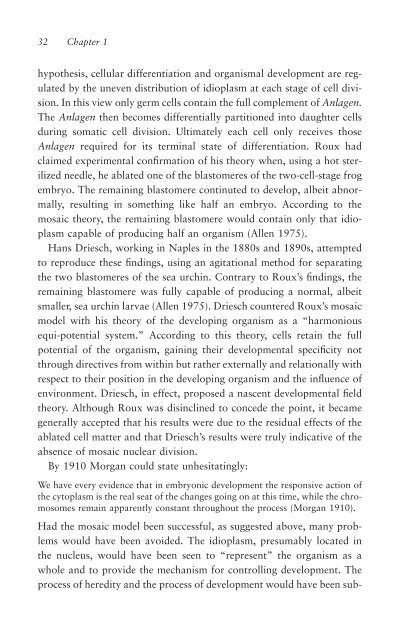A Critique of Pure (Genetic) Information
A Critique of Pure (Genetic) Information
A Critique of Pure (Genetic) Information
You also want an ePaper? Increase the reach of your titles
YUMPU automatically turns print PDFs into web optimized ePapers that Google loves.
32 Chapter 1<br />
hypothesis, cellular differentiation and organismal development are regulated<br />
by the uneven distribution <strong>of</strong> idioplasm at each stage <strong>of</strong> cell division.<br />
In this view only germ cells contain the full complement <strong>of</strong> Anlagen.<br />
The Anlagen then becomes differentially partitioned into daughter cells<br />
during somatic cell division. Ultimately each cell only receives those<br />
Anlagen required for its terminal state <strong>of</strong> differentiation. Roux had<br />
claimed experimental confirmation <strong>of</strong> his theory when, using a hot sterilized<br />
needle, he ablated one <strong>of</strong> the blastomeres <strong>of</strong> the two-cell-stage frog<br />
embryo. The remaining blastomere continuted to develop, albeit abnormally,<br />
resulting in something like half an embryo. According to the<br />
mosaic theory, the remaining blastomere would contain only that idioplasm<br />
capable <strong>of</strong> producing half an organism (Allen 1975).<br />
Hans Driesch, working in Naples in the 1880s and 1890s, attempted<br />
to reproduce these findings, using an agitational method for separating<br />
the two blastomeres <strong>of</strong> the sea urchin. Contrary to Roux’s findings, the<br />
remaining blastomere was fully capable <strong>of</strong> producing a normal, albeit<br />
smaller, sea urchin larvae (Allen 1975). Driesch countered Roux’s mosaic<br />
model with his theory <strong>of</strong> the developing organism as a “harmonious<br />
equi-potential system.” According to this theory, cells retain the full<br />
potential <strong>of</strong> the organism, gaining their developmental specificity not<br />
through directives from within but rather externally and relationally with<br />
respect to their position in the developing organism and the influence <strong>of</strong><br />
environment. Driesch, in effect, proposed a nascent developmental field<br />
theory. Although Roux was disinclined to concede the point, it became<br />
generally accepted that his results were due to the residual effects <strong>of</strong> the<br />
ablated cell matter and that Driesch’s results were truly indicative <strong>of</strong> the<br />
absence <strong>of</strong> mosaic nuclear division.<br />
By 1910 Morgan could state unhesitatingly:<br />
We have every evidence that in embryonic development the responsive action <strong>of</strong><br />
the cytoplasm is the real seat <strong>of</strong> the changes going on at this time, while the chromosomes<br />
remain apparently constant throughout the process (Morgan 1910).<br />
Had the mosaic model been successful, as suggested above, many problems<br />
would have been avoided. The idioplasm, presumably located in<br />
the nucleus, would have been seen to “represent” the organism as a<br />
whole and to provide the mechanism for controlling development. The<br />
process <strong>of</strong> heredity and the process <strong>of</strong> development would have been sub-
















